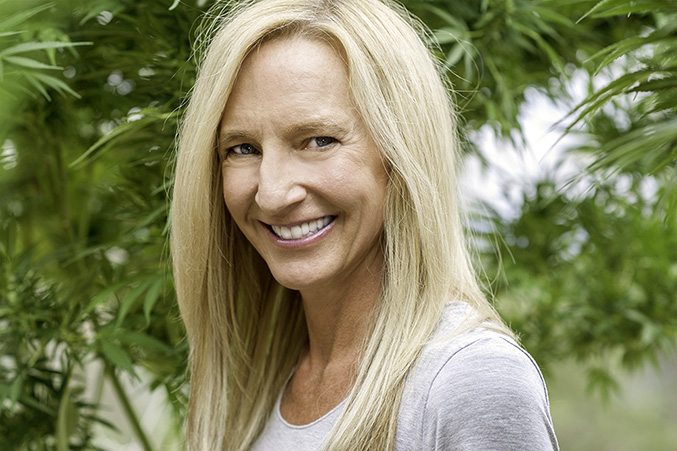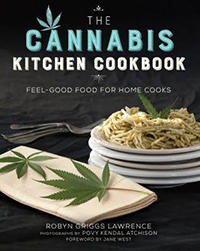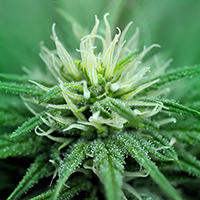Robyn Griggs Lawrence. Photo by Tracey Eller for Cosmic Sister
Cannabis Kitchen Cookbook author Robyn Griggs Lawrence explains why she’s proud to be a canna-mom
I’ve answered a lot of questions since the release of my book, The Cannabis Kitchen Cookbook, in 2015. Family members, friends, reporters, acquaintances and strangers want to know why I cook with cannabis and, sometimes, how they can, too. A surprising number of people don’t even know, until I tell them, that they can cook with the herb.
People who knew me as a volleyball mom and natural living advocate ask why I would write a book promoting use of a substance that’s illegal in most of the world (but not in my home state, Colorado). People ask how my social life has changed since I began speaking and publishing about cannabis.
When you go public, you get a lot of questions about your private life. I answer as best I can.
I tell them I eat cannabis leaves and flowers because the plant is a nutritional powerhouse. Officially classified as a vegetable, it’s packed with vitamins, essential fatty acids, zinc, magnesium and antioxidants. It’s as good for you as kale—and should be grown or chosen with as much care as you use when shop for kale. Access to cannabis grown to certified organic standards is a basic healthcare right that most of the world is being denied.
I’m alarmed that we can’t have organic standards and regulations for cannabis because it’s federally illegal in the United States. Merchants can claim cannabis is “organic” when it’s grown using insecticides, pesticides, fungicides and herbicides that aren’t safe for human consumption. Dispensaries and retail outlets can get away with selling cannabis with mold and powdery mildew, which can cause serious health issues. Until standards are put into place, vigilante consumerism is required.
I like to juice cannabis fan leaves, and I believe that’s the best way to take in all of the plant’s nutritional and medicinal benefits. It’s hard to find enough leaves year-round, though, so I make a lot of infusions and tinctures, which pull terpenes and cannabinoids out of the plant material.
Making infusions is simple. THC-A and CBD-A, the most well-known cannabinoids in the cannabis plant, are fat-soluble, and heat turns THC-A into psychoactive THC while activating CBD-A. Gently heating ground cannabis with a fat (butter, oil, cream, honey) for several hours pulls out all the goodies and gives you a great base to use in any type of recipe. Combining cannabis and alcohol creates the same effect, and these cannabis tinctures make a great base for cocktails—one, just one.
Why do I go to all the trouble? Because cannabis is a medicinal food that competes with opioids in its capacity to relieve severe pain as well as nausea and muscle spasms. Cannabis eases my severe menstrual cramps (and the hormonal rage that comes with them) and soothes raging inflammation from leaky gut syndrome. (I told you I have to get personal.)
Since I wrote the cookbook, I’ve met dozens, who are among hundreds, of “canna-moms” who have moved their families from states where cannabis is illegal to Colorado, where it’s legal, to treat their children with autism, epilepsy and seizures. Pharmaceuticals have failed and, in some cases, nearly killed their children. These women are passionate, driven advocates for bringing this medicine to everyone, and hanging out with them is one cool way my social life has changed—to answer that question.
These days, I go to a lot more parties where cannabis, not alcohol, is the main focus. I meet the most interesting people. Cannabis feels good and brings out great conversation. No one regrets anything in the morning.
I prefer cannabis to a martini for rounding my corners. It’s far safer than alcohol, and that’s a point I want to bring up when I have to answer another inevitable question: But what about the children?
I’ve learned how to talk about my bodily failings and associated mania, but I struggle when this subject comes up because I have children. My son is 22, but my daughter is 18, underage in the United States. I can’t condone or permit that she break the law, but I lived across from the high school for nine years and heard a lot of lunchtime conversations. The girls who got naked on the stripper pole in the party bus, or way worse, were drinking alcohol, not imbibing cannabis.
This year my daughter is a college freshman, and she knows she’s entered a rape culture fueled in part by alcohol. She and her friends talk about it all the time. I want to tell them they’re far less likely to be roofied, raped or ridiculed if they bring their own vape pens to parties rather than risking the drinks. I can’t because underage use is illegal.
I wasn’t willing to use cannabis or speak out about it until I felt safe that I was working within the law. Now, I realize that being able to share what I’ve learned about integrating cannabis into a healthy lifestyle is a privilege. That’s why I answer the questions—even when I don’t want to.
Everyone, everywhere, should be able to dig into a bowl of pasta with fresh fan leaves, stir cannabis honey into afternoon tea, and spin raw cannabis flowers into a morning smoothie without worrying about being a criminal.



